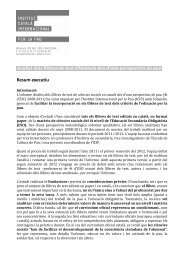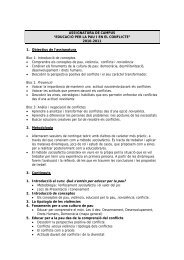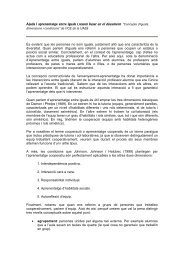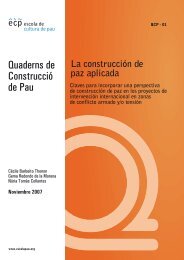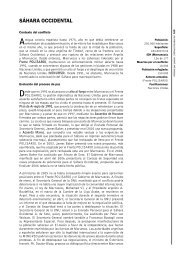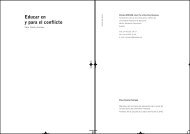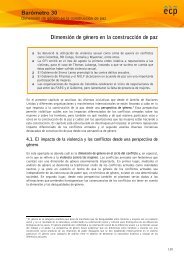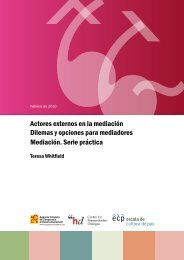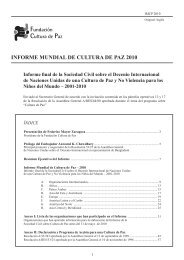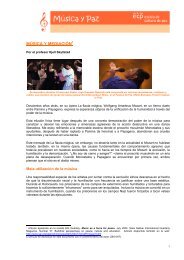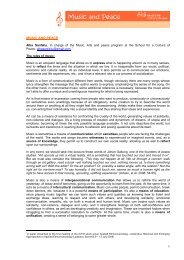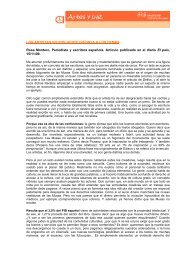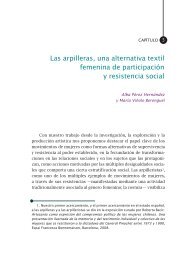PROSPERITY AND PEACE THROUGH ART
PROSPERITY AND PEACE THROUGH ART
PROSPERITY AND PEACE THROUGH ART
Create successful ePaper yourself
Turn your PDF publications into a flip-book with our unique Google optimized e-Paper software.
<strong>PROSPERITY</strong> <strong>AND</strong> <strong>PEACE</strong> <strong>THROUGH</strong> <strong>ART</strong><br />
Ashfaq Ishaq; Executive Director, International Child Art Foundation. Washington DC, USA 1<br />
http://www.icaf.org<br />
KEYWORDS<br />
Conflicts and Ethics, Sport and Art, Millennium Development Goals, Arts Olympiad, Peace<br />
through Art, Creativity for Peace, Healing Arts, Global Peace Building, Framework to Evaluate<br />
Benefits of the Arts<br />
ABSTRACT<br />
Since its founding in 1997, the International Child Art Foundation (ICAF) has made a unique<br />
contribution to global advocacy for arts education and integrating the arts with science, sport<br />
and technology. More importantly, the ICAF has demonstrated how the arts can be applied to<br />
achieve important social objectives. The ICAF programs guide schools to encourage children’s<br />
creativity, instill empathy and understanding, and inspire creative global leadership. Under the<br />
ICAF umbrella, teachers bring the world of arts and cultures to their classroom, providing<br />
students with an opportunity to experience and appreciate the varied manifestations of human<br />
creativity that make earth – a fragile planet in a remote galaxy – still the most wondrous place in<br />
the whole universe.<br />
THE MILLENNIUM CHALLENGE<br />
At the dawn of the 21st century the world’s leaders defined the Millennium Development Goals<br />
(MDGs) to be achieved by the target date of 2015. These goals are; (i) eradicate extreme<br />
poverty and hunger; (ii) achieve universal primary education; (iii) promote gender equality and<br />
empower women; (iv) reduce child mortality; (v) improve maternal health; (vi) combat HIV/AIDS,<br />
malaria and other diseases; (vii) ensure environmental sustainability; and (viii) develop a global<br />
partnership for development.<br />
In September 2005 the leaders met again at the UN World Summit and expressed their<br />
determination to ‘establish a just and lasting peace all over the world’ and committed<br />
themselves to ‘promoting education for peace and human development.’ (www.un.org/summit)<br />
Almost two thousand years earlier, the Roman philosopher Seneca in 42 A.D. concluded that<br />
world peace will be secured on a permanent basis when we start teaching our children to view<br />
the whole world as one: Omnis orbs terrarumpatria mea est. (The whole world is my own native<br />
land). His advice was ignored and almost every successive century since has been bloodier<br />
than the one before. In the bloodiest-ever twentieth century, Mahatma Gandhi reminded us that:<br />
‘If we are to teach real peace in this world, and if we are to carry on a real war against war, we<br />
shall have to begin with the children.’<br />
What is the future of this century? Will conflicts and violence mushroom or will creative and<br />
cooperative communities bloom across the globe? Children can build a more just, prosperous<br />
and non-violent world, but only with the aid of global programs that nurture their innate creativity<br />
and intrinsic empathy.<br />
This paper explains the importance of creativity and empathy as key attributes of successful<br />
learners and leaders. The links between art and creative development and art and empathic<br />
understanding are examined. Global programs of the International Child Art Foundation (ICAF)<br />
that promote creativity and empathy are evaluated, and a novel concept of ‘artist athlete’ is<br />
introduced for holistic development of children. Lastly, the social and private benefits of<br />
1<br />
This article is available at http://www.abp.unimelb.edu.au/unesco/ejournal/pdf/prosperity-peace.pdf , UNESCO<br />
Observatory, faculty of architecture, building and planning, the university of Melbourne refereed e-journal. Used by<br />
permission of the author (03/08/09)<br />
1
organisations such as the ICAF and the United Nations Educational, Scientific and Cultural<br />
Organisation (UNESCO) are discussed.<br />
INNATE CREATIVITY<br />
In 1950, an article titled ‘Creativity’ in American Psychologist described a model for the human<br />
intellect that made a distinction between ‘convergent’ thinking (a single, correct solution to a<br />
problem) and ‘divergent’ thinking (multiple solutions, all of which could be correct and<br />
appropriate) (Guilford, 1950: 444-454). This distinction helped neurobiologist Roger W. Sperry<br />
in the 1960s to discover the two hemispheres of the brain, the left brain responsible for<br />
convergent thinking and the right brain for divergent thinking, which underlies the ability to be<br />
creative (for his discoveries concerning the functional specialisation of the cerebral hemispheres,<br />
Sperry was awarded the Nobel Prize for Medicine in 1981).<br />
Also in the 1960s, educational psychologist E. Paul Torrance launched longitudinal studies to<br />
investigate why all children are creative but most adults are not. Later recognised as the ‘father<br />
of creativity,’ Torrance discovered the ‘fourth-grade slump’ that defines a period when children<br />
face a decline in their creativity, which may continue throughout the school years into adulthood<br />
(Torrance, 1968). More recently it has been noted that the fourth-grade slump can relate to<br />
maturational processes or to an emphasis on conforming behavior, but in either case it can be<br />
overcome (Runco, 1999: 743-44).<br />
Nurturing and sustaining creativity is gaining public attention as economies shift their emphasis<br />
from productive industrial workers to creative knowledge workers (Homer-Dixon, 2000; Florida,<br />
2002; Mitchell, Inouye, Blumenthal, 2003). It was also observed that most research indicates<br />
that schools do not promote creativity; in fact, traditional educational practices may well be a<br />
deterrent to creativity (Sternberg, Lubart, 1991: 1-32). UNESCO has found that the instinctive<br />
capacity for creativity and imagination found in young people has often been denied or<br />
suppressed in their education: ‘The encouragement of creativity from an early age is one of the<br />
best guarantees of growth in a healthy environment of self-esteem and mutual respect – critical<br />
ingredients for building a culture of peace.’ (www.unesco.org). When education is skewed to the<br />
left brain, the right brain does not develop to its potential. A consensus has developed in<br />
creativity literature that ‘all of us can make better use of the creative abilities we are born with’<br />
(Davis, 1991).<br />
Prominent educators view the fostering of creativity as a key component in school reform<br />
(Gardner, 1999, Robinson, 2001). Scientists have called for a general creative surge in all areas<br />
of life. For them creativity is a major need of each human being and the blockage of creativity<br />
eventually threatens civilisation with ultimate destruction (Bohm, Peat, 2000). Joseph Beuys has<br />
said: ‘creativity is national income.’ (Robinson Report, 1999: 54).<br />
<strong>ART</strong> <strong>AND</strong> CREATIVITY<br />
Art has a broader function in defining us and modifying our views of our societies and ourselves.<br />
According to cognitive neurobiologist Zeki ‘the acquisition of knowledge by registering the<br />
constant and essential characteristics of objects is the primordial function of the visual brain. It<br />
is also the primordial function of art That is why many great philosophers concerned with the<br />
problem of knowledge, from Plato onward, have devoted large parts of their work to discussion<br />
of art.’ (Zeki, 2001: 51-2).<br />
Art is the native language of children and children’s innate creativity is a provenance of human<br />
achievement. Although scientific understanding of creativity is far from complete, researchers<br />
claim that a child who is exposed to the arts in school has the potential to become a more<br />
creative, imaginative, expressive, confident, self-reliant and critically thinking individual (O’<br />
Farrell, Meban, 2003). It has been suggested that it is possible to enhance children’s creative<br />
skills through art-based programs (Scope, 1999; Robinson Report 1999).<br />
2
A research review for UK’s National Foundation for Educational Research found mixed results<br />
that depended upon researchers’ definition of creativity and degree of emphasis on creative<br />
outcome versus creative process (Sharp, 2001). This particular scoping exercise focused on<br />
young children (ages 3 to 6 years), which is not the age group (ages 8 to 12) generally<br />
associated with facing the risk of the fourth-grade slump.<br />
An interview of child artists (ages 8 to 14) at the 2003 ICAF festival in Washington DC found<br />
that these young artists defined creativity as ‘expressive creativity’ – where the art itself<br />
becomes an indicator or predictor of creativity. Climate and environment – both physical and<br />
psychological – emerged as key assisters to the creativity of child artists, while the key<br />
detractors were distractions (noise, friends, school) and motivation (laziness, depression,<br />
stubbornness) (Murdock et al, 2004).<br />
In a survey of the ICAF alumni in 2005 the focus was on learning these young artists’ views on<br />
creativity (The ICAF alumni or Art Olympiad finalists are the children selected to represent their<br />
home state or country at the ICAF festivals based on global art competitions that emphasise<br />
originality and imagination). The young artists were found to value creativity as essential to their<br />
living a well-rounded life. For Natasha Janner (age 17 in Oregon, USA), creativity provides good<br />
ideas for all areas of life. ‘Creativity leads us to innovation, which gives us the power to invent,’<br />
says Philbert Tiki Yong (age 13 in Kuala Lumpur, Malaysia). ‘Creativity is important to me<br />
because it lets me express what I think and feel in different ways,’ says Alejandro Goldzycher<br />
(age 15 in Buenos Aires, Argentina). Creativity ‘decorates the artwork with a sense of<br />
uniqueness,’ says Chathura Arachchi (age 17 in Colombo, Sri Lanka). Tamara Mamedova (age<br />
17 in Baku, Azerbaijan) feels that there is something divine about creativity. It is associated with<br />
the Creator. ‘It gives me the possibility to create my own world.’<br />
INTRINSIC EMPATHY<br />
Nurturing the innate creativity of children is a necessary but not a sufficient condition for a more<br />
just, prosperous and non-violent world. The complexity of local and global issues requires<br />
cooperative problem-solving, drawing on viable solutions. To be viable, however, solutions must<br />
respectfully and transparently address competing equities in a search for common ground and<br />
compromise. Individuals who demonstrate empathy are therefore more capable problemsolvers<br />
and leaders. Empathy is the ability to understand and enter the feelings, thoughts and<br />
motives of another; it does not imply acceptance or agreement, or losing oneself to become<br />
another, but rather identifying with and understanding another’s reasons and reactions.<br />
The process of developing empathy involves: emotional literacy, defined as the ability to identify<br />
and express one’s own emotions; and emotional intelligence, defined as the ability to correctly<br />
and comprehensively read another person’s emotions. (Goleman, 1995 helped popularise<br />
emotional intelligence, just like Florida, 2002 raised public awareness of creativity and the<br />
creative class).<br />
A review of the literature on developing empathy in children and youth – some fifty-eight articles<br />
and books – concluded that for a growing number of educators the developing of empathy is a<br />
key attribute of education (Cotton, 2001). A research-based definition of the successful learner<br />
includes being empathetic as a major attribute (Jones, 1990). It can also be argued that<br />
empathy fosters both creative and critical thinking (Gallo, 1989: 23, 98-115).<br />
Scholars focusing on the structural conditions necessary for creativity also point to the<br />
importance of collaboration. It has been found that creativity seems to thrive within teams and<br />
collaborative circles (Tepper, 2004: 51). Creative individuals thrive and feed off the energy of<br />
others, laying foundations for industry clusters (Porter, 1990) and for creative communities<br />
(Eger, 2003).<br />
3
<strong>ART</strong> <strong>AND</strong> EMPATHY<br />
Through the arts children can be introduced to the world without coloring their perceptions with<br />
conflicts old and new; research indicates that students’ attitudes towards foreign cultures are<br />
more positive when similarities are stressed rather than differences (Hahn, 1980). The arts can<br />
then become a key component in a moral-cognitive approach to education – ‘the arts, with their<br />
inextricable ties to imagination, have the capacity to provide an unlimited source of possibilities<br />
for connecting self to other and for creating a disposition for sympathetic awareness.’ (Stout,<br />
1999: 52,2,21-34). Such awareness promotes peer-to-peer learning and a spirit of cooperation.<br />
The decade-long work of the ICAF shows that the process of developing cooperation to<br />
advance a common agenda involves the following stages:<br />
Creativity > Communication > Empathy > Cooperation<br />
The ICAF employs the arts as a dynamic channel to foster creativity and as a languageindependent<br />
media to promote communication (according to the National Endowment for the<br />
Arts [NEA, 2004] chairman Dana Gioia, ‘a number of research studies over the past several<br />
decades have drawn a clear correlation between early exposure of children to the arts and<br />
increased long-term critical reasoning, communication, and social skills.’) The global programs<br />
and educational publications of the ICAF open young minds to the world through the arts.<br />
Students across the globe benefit from free lesson plans and get to see other children’s art<br />
online or through art exchanges between schools. Correspondence and email communication<br />
between students further cements their international education and understanding.<br />
An underlying purpose of the ICAF festivals is to develop empathy. Creative children from<br />
different national, cultural, ethnic, social and religious backgrounds come face-to-face and for a<br />
week play, eat, enjoy performances, and make art together. Participation in art activities<br />
encourages cooperative learning and pro-social interaction, which has its own attendant<br />
academic and social benefits. Through collaborative projects like mural making, they develop<br />
meaning and significance together, resulting in ‘relational empathy’ (Broome, 1991: 40, 235-<br />
249). The children make emotional connections that invoke compassion and develop empathy.<br />
Child artists participating in the festivals confirm these observations. Jenna Skophammer<br />
represented Iowa at the first-ever national children’s art festival in the United States hosted by<br />
the ICAF in 1998 in Washington, DC. She wrote: ‘I really enjoyed working on the U.S. Mural. It<br />
was one of the best experiences of my life!’ Carmen Ortiz represented Louisiana in the 2003<br />
World Children’s Festival and wrote: ‘I met a lot of people from tons of places and learned all<br />
about a lot of different customs and languages. I participated in many fun art activities, with a<br />
different theme chosen to paint each day. I have kept in touch with many artists I met at the<br />
festival by email and letters.’<br />
STYLES OF EDUCATION<br />
Why is developing creativity and empathy not on the global agenda? The roots of this neglect lie<br />
in the European Enlightenment, which ‘led to a view of knowledge and intelligence dominated<br />
by deductive reason and ideas of scientific evidence. These ideas have been reinforced since<br />
then by the styles of formal education, promoted especially through the public schools and<br />
universities. These methods of thoughts have had spectacular success in shaping our<br />
understanding of the world and in generating technological advances. But there has been a<br />
terrible price too.’ (Robinson, 2001: 8). One aspect of this terrible price is the lack of empathy in<br />
a world that otherwise is fairly well connected because of advances in communications,<br />
information, transportation and the omnipresence of the Internet.<br />
To initiate or accelerate scientific and technological development today, policy makers typically<br />
focus on science and technology education and overlook the arts. The ICAF advocates<br />
4
integration of art education by demonstrating the interaction between scientific and<br />
technological development and arts and cultural development.<br />
<strong>PEACE</strong> <strong>THROUGH</strong> <strong>ART</strong><br />
In response to the September 11, 2001 tragedy, the ICAF developed a Peace through Art<br />
approach in collaboration with psychiatrists, psychologists, art therapists and conflict resolution<br />
experts. The objective is to reduce the trans-generational transmission of trauma and hatred by<br />
drawing upon the creativity and imagination of young people to learn the ethics of responsibility<br />
(Ishaq, 2006: 526-27). The approach calls for peace education and art activities organised<br />
under the following four sequential modules:<br />
• Learning through Experience. Participants learn to understand their responses to<br />
conscious and subconscious resistance and trauma, some of which are reflected in their art;<br />
• Conflicts and Ethics. Participants learn the reasons for conflict and methods to<br />
alleviate tension through artistic expression;<br />
• Creativity for Peace. Participants learn how to use the arts for confidence building and<br />
developing empathy, and they collectively create works of art to experience the power of team<br />
creativity; and<br />
• Role Models for Society. Participants learn to apply their own creativity to build a vision<br />
of peace and coexistence in their communities.<br />
To field test the approach, a three-week Peace through Art program was organised in July 2002<br />
in Washington, DC for 10 Greek-Cypriot and 10 Turkish-Cypriot youth aged 14-15 who had<br />
grown up on opposite sides of the ‘Green Line’ dividing the island. The participants have<br />
maintained the friendships formed during the program, a benchmark in achieving the<br />
methodology’s objectives of preparing Cypriot youth for peaceful coexistence and development<br />
of the necessary skills to become peace advocates and conflict mediators (The approach has<br />
the potential to expand to help overcome and repair other societal stressors besides state<br />
conflicts.<br />
HEALING <strong>ART</strong>S<br />
Rebuilding a community devastated by a natural disaster has economic, social and<br />
psychological dimensions. In response to the December 24, 2004 tsunami in Asia, the ICAF<br />
developed a Healing Arts program to transfer the knowledge and experience gained from the<br />
treatment of the child survivors of the 9/11 tragedy and other recent disasters to help the<br />
tsunami child survivors.<br />
Scientific studies on the psychological effect of the 9/11 attack on the World Trade Center found<br />
that directly affected children were at risk for a variety of mental health problems including<br />
anxiety disorders, post- traumatic stress disorder and childhood traumatic grief - a condition<br />
affecting those who experience a death under traumatic circumstances. Preventing and treating<br />
the distress experienced by children as soon as possible is crucial for optimal long-term health<br />
and recovery. Parents, caregivers and teachers of these children were found to minimise,<br />
ignore, deny and criticise, or be sensitive to the plight of the children, depending upon their own<br />
recovery and progress.<br />
Although the circumstances and implications are different for every natural disaster, the<br />
knowledge gained from one tragedy is useful in diagnosis and treatment of the survivors of<br />
another. Healing Arts programs can be effective tools in community building and reconstruction,<br />
be it a town in the U.S. Gulf Coast devastated by Hurricane Katrina or a hamlet in the<br />
5
Himalayas wrecked by an earthquake. The following steps comprise the ICAF Healing Arts<br />
program:<br />
• Develop training materials. A training manual is prepared which describes best<br />
practices and provides practical suggestions on what children should be encouraged to paint or<br />
draw, and helpful coping strategies to avoid traumatising children by other children's stories or<br />
art;<br />
• Identify, train and coordinate volunteers. Enlist and mobilise expert and other<br />
volunteers to work on different components of the program; coordinate art therapy workshops in<br />
schools, orphanages and shelters;<br />
• Identify, collect and ship art and school supplies. Determine what teachers in the<br />
affected areas need and ship art and school supplies to them;<br />
• Promote empathy through encouragement art. Encourage children not affected by the<br />
disaster to create ‘encouragement art’ that provides hope to other children affected by the<br />
disaster. Such art creation, international exchange and exhibitions help promote empathy and<br />
awareness;<br />
• Psychological intervention for the traumatised. Identify the most severe cases for<br />
psychological treatment, in consultation with local teachers and parents; and<br />
• Evaluation of response. Evaluate the program and determine the need for program<br />
extension and modification.<br />
Like emergency assistance organisations, the ICAF had not planned to organise Healing Arts<br />
Programs but did so in response to the three major natural disasters that shocked the world in a<br />
ten-month period from December 2004 to October 2005. Unlike emergency assistance<br />
organisations, the ICAF is not in the business of disaster relief but responded to the urgent<br />
pleas for help from its country partners in Sri Lanka, India and Pakistan and schoolteachers in<br />
the Gulf Coast of Mississippi. However, based on these experiences, the ICAF has acquired a<br />
knowledge base to respond to natural disasters more effectively.<br />
GLOBAL <strong>PEACE</strong> BUILDING<br />
The Peace through Art methodology underlies the ICAF Arts Olympiad program, which inspires<br />
children to be creative and cooperative. A free global program with a four-year cycle, the Arts<br />
Olympiad commences in classrooms with free structured lesson plans distributed to schools<br />
worldwide. School art competitions on a universal theme follow, and lead to national and<br />
regional celebrations. The Arts Olympiad culminates in the World Children’s Festival,<br />
traditionally held every four years at the National Mall in Washington, DC.<br />
The Third Arts Olympiad (2005-2008) recognises that two ways in which children naturally gain<br />
and apply life-skills are through artistic expression and athletic accomplishment. The Arts<br />
Olympiad lesson plan and art competition combines these two areas through the theme ‘My<br />
Favorite Sport.’ The Arts Olympiad promotes the Olympic ideals of tolerance and cooperation<br />
and celebrates the ‘artist-athlete’ ideal of a creative mind and healthy body.<br />
Global peace education elements of the Arts Olympiad are outlined below:<br />
• Community cohesion. The Arts Olympiad Lesson Plan is designed for a typical<br />
classroom comprised of two groups: students interested in sports and students interested in the<br />
arts. Each group is urged to examine the motivation and objectives of the other, and discuss the<br />
application of the Olympic ideals in sports and art. The athletes create an art project based on<br />
sporting gear (a ball, bat or sneaker) while the artists create a sports game based on art tools (a<br />
palette, mouse or easel). The concept of ‘artist-athlete’ is introduced to bring the two groups<br />
together, and promote both mental and physical development. The students create art on the<br />
theme, ‘My Favorite Sport,’ and later help their teachers in the selection of the finalists, which<br />
enhances their self-confidence, objectivity and visual aesthetics.<br />
6
• Nation building. The national festivals encourage children to apply their creativity to<br />
build a vision of peace and coexistence in their communities. ICAF encourages its country<br />
partners to host national exhibitions and celebrations, typically bringing together 20 to 50<br />
finalists for a 2- or 3-day-period. First the children bond through common interests, including art<br />
and sport. Then they discuss their differences and divisions. Art and sport activities follow to<br />
alleviate tensions. Then they collaboratively create a national mural that reflects their national<br />
identity. Finally they help select the national finalists who will represent their country at the ICAF<br />
festivals. The selection criteria recognise not only exceptional artistic talent, but exceptional<br />
abilities in other creative fields – oration, writing, theatre, music, etc. – as well as academic<br />
excellence and emotional intelligence, to identify creative and empathetic children who have<br />
leadership potential.<br />
• Regional identity. National finalists from each continent come together at regional<br />
festivals organised by the ICAF and its partners. The festival objective is to provide children a<br />
sense of regional identity and to help diffuse nationalistic zeal in order to facilitate regional union<br />
or integration. Teachers and parents accompany the national finalists, as do country partners;<br />
over the course of the five-day festival, they participate in special programs to promote<br />
cooperation. The children play regional sports and work together to create a large mural on<br />
which their region (or continent) is outlined, while the adults have an opportunity to initiate<br />
bilateral ‘neighbour-our-friend’ programs to ease tensions between countries that have common<br />
borders.<br />
• Global understanding. The national finalists from across the globe come together at<br />
the World Children’s Festival. The objective of the weeklong festival is to celebrate the ‘artistathlete’<br />
and build a nexus for the future. Art and sport serve as common grounds for bonding<br />
and relaxation. Art therapy is used to reduce trauma where necessary and to open young minds<br />
to new possibilities. Children are encouraged to discuss their differences and commonalities<br />
under the supervision of experts where necessary. They participate in workshops on developing<br />
empathy and sustaining creativity, sometimes accompanied by their teachers and parents. They<br />
display their musical, theatrical and debating talents at the ‘world stage’ where impromptu<br />
performances are encouraged. Equipped with a repertoire of new skills, universal values and<br />
newfound confidence, they begin preparations for global leadership roles. (Ishaq, 2005:36-9).<br />
The ICAF is still a young organisation with a global outreach that is steadily growing. More than<br />
two million children have already participated in its First Arts Olympiad (1997-2000) and the<br />
Second Arts Olympiad (2001-2004). Nearly three million children in 100 countries have<br />
participated in the Third Arts Olympiad.<br />
EVALUATING THE BENEFITS OF THE <strong>ART</strong>S<br />
A study on the benefits of the arts provides a framework for understanding the benefits of the<br />
arts by distinguishing between intrinsic and instrumental benefits and private and public benefits<br />
(McCarthy et al, 2004). The intrinsic benefits are inherent in the arts experience and add value<br />
to one’s life. The instrumental benefits arise from the arts helping achieve broad social and<br />
economic goals that have nothing to do with the arts per se. Private benefits accrue to an<br />
individual, while the community shares public benefits. In addition there are spillover benefits,<br />
that is, benefits that are both private and public.<br />
The R<strong>AND</strong>/Wallace framework is presented below:<br />
Figure 1. The R<strong>AND</strong>/Wallace framework on benefits of the arts.<br />
7
In Figure 1 intrinsic benefits are along the top and instrumental benefits along the bottom.<br />
These benefits are arranged along a spectrum of private benefits, spillover benefits and public<br />
benefits.<br />
Intrinsic benefits of the arts enjoyed exclusively by individuals are captivation or rapt absorption.<br />
Such focused attention connects individuals more deeply to the world and opens them to new<br />
ways of seeing and experiencing the universe, with greater intensity; and pleasure, leading to<br />
intense imaginative experience, new meanings, and the sense of deep satisfaction. Intrinsic<br />
benefits for the public are the creation of social bonds and expression of communal meanings.<br />
The spillover benefits are expanded capacity for empathy, an increased receptivity to unfamiliar<br />
people, religions and cultures; and cognitive growth, the gaining of entirely new insights and<br />
perspectives.<br />
An instrumental benefit of the arts enjoyed exclusively by individuals is the increased learning<br />
aptitude that leads to improved test scores. Instrumental benefits for the public are the<br />
development of social capital (a sense of community identity) and the arts’ economic impact<br />
(economic benefits are comprised of direct [employment], indirect [creative communities] and<br />
‘public good’ [public satisfaction] benefits).The spillover benefits are attitudinal and behavioral<br />
changes that lead to improved self-efficacy and learning skills, as well as therapeutic benefits<br />
that enhance healing and public wellness.<br />
The above framework, although comprehensive for school- and community-based arts<br />
programs and organisations, does not capture all the benefits provided by innovative global<br />
programs of organisations such as UNESCO and the ICAF. In the case of the ICAF, the Arts<br />
Olympiad and other programs, festivals and exhibitions, and publications for children such as<br />
the ChildArt magazine, have actually enhanced the benefits of the arts and art education. The<br />
impact of the ICAF includes all the benefits listed in Figure 1. In addition, the ICAF programs<br />
nurture a child’s innate creativity and provide unique instrumental benefits by employing the arts<br />
to heal, inspire and unify children across the globe. In Figure 2 public benefits expand into<br />
global benefits and spillover benefits imply those that accrue to a single community or country.<br />
Figure 2: ICAF’S UNIC BENEFITS<br />
8
The ICAF attempts to help sustain the creativity of the Arts Olympian finalists through<br />
mentorship, as is the case with the ICAF Youth Board (private benefits), (in 2007 the ICAF<br />
Youth Board was comprised of 35 Arts Olympians, creative young people selected as national<br />
finalists or U.S. state finalists under ICAF’s Arts Olympiads). Creative development leads to<br />
innovations and inventions, spurring the development of cultural industries and boosting<br />
economic growth (spillover benefits). In fact the cultural industries are the second-fastest<br />
growing sector in the UK economy (Arts Council England, 2005). Creative industry clusters are<br />
springboards for the development of creative communities worldwide (global benefits).<br />
The arts and creative opportunities provided by the ICAF help transform the way children learn<br />
and explore the world around them. Being creative also helps them adapt and respond to a<br />
rapidly changing world. Empathy and global engagement through the Arts Olympiad enhances<br />
an individual’s prospects in a global economy where competition for jobs and entrepreneurial<br />
success is becoming more intense (private benefits). Global awareness leads to the<br />
development of multicultural competencies that help unite communities (spillover benefits) an<br />
example of which is the ICAF Healing Arts programs in response to the Asian tsunami,<br />
Hurricane Katrina and the catastrophic earthquake in Pakistan Global understanding promotes<br />
acceptance of universal values and the capacity to envision alternative and more hopeful<br />
futures (global benefits) – by disseminating the children’s artworks through festival properties<br />
and licensing agreements, ICAF shares with a world beset by poverty, conflict and lack of<br />
opportunity, the hope in a child’s eye.<br />
The Arts Olympiad also enhances creative leadership skills (Ishaq, 2005b). Since the traditional<br />
national leadership models are limited by their aims and scope, several major multinational<br />
corporations have already set up their own global leadership departments to train future<br />
corporate leaders. Leadership skills better position individuals for success in life (private gains).<br />
Creative leadership abilities are needed to build peace in conflict zones and increase<br />
communities’ ability to manage social, economic and cultural stressors (spillover benefits). Also,<br />
through the ICAF programs children can learn to communicate across language barriers,<br />
visualise a peaceful future, and gain the ability to prosper in open, pluralistic societies (global<br />
benefits).<br />
Buttressing these benefits is the Arts Olympiad’s track record of positive results in the training of<br />
teachers and parents. Through their participation in the program, teachers arrange art<br />
exchanges with schools in other countries and in the process come into contact with teachers<br />
from around the world. Parents, too, become involved, often sharing with and encouraging their<br />
children in their work. Workshops on how to sustain creativity and support leadership<br />
development are organised at the ICAF festivals for both teachers and parents.<br />
9
CONCLUDING THOUGHTS<br />
Innate creativity and intrinsic empathy are the two pillars on which human achievement and<br />
global security are founded. There is a need to re-evaluate the goals of children’s education to<br />
measure up to the 21st century. The world’s leaders have thus far failed the children and young<br />
people who today comprise a majority in the world’s population. Global frameworks such as the<br />
Millennium Development Goals overlook the fundamentals and rely instead on a top-down<br />
framework and trickle-down mechanism. The much-celebrated UN Convention on the Rights of<br />
the Child neglects the child’s right to be creative and to be empathetic. Globalisation and the<br />
digital revolution, the benefits of which are yet to fully unfold, can promote not only<br />
communication per se but empathy and cooperation, provided that children are free to realise<br />
the interplay of humanitarian ideals. A simple common denominator among children, like the<br />
arts, has more value today than in the past.<br />
REFERENCES<br />
Arts Council England (2005). Children, young people and the arts. London, September.<br />
Bohm, D., and Peat, F. D, (2000). Science, order, and creativity. Routledge, Oxford, second<br />
edition.<br />
Broome, B.J. (1991) Building shared meaning: implications of a relational approach to empathy<br />
for teaching intercultural communication. Communication Education.<br />
Cotton, K. (2001). Developing empathy in children and youth. School improvement research<br />
series, Northwest Regional Educational Laboratory, Portland, Oregon.<br />
Davis, G. A. (1991) Teaching creativity thinking. In Colangelo, N. and Davis, G.A. (eds.)<br />
Handbook of gifted children. Allyn & Brown, Boston.<br />
Eger, J. (2003). The creative community. The California Institute for Smart Communities, San<br />
Diego.<br />
Florida, R. (2002). The rise of the creative class. Basic Books, New York.<br />
Gallo, D. (1989). Educating for empathy, reason and imagination. Journal of Creative Behavior<br />
Gardner, H. (1999). Art education and human development. Getty Center for Education in the<br />
Arts, Santa Monica, California.<br />
Goleman, D. (1995). Emotional intelligence: why it can matter more than IQ. Bantam, New York.<br />
Guilford, J.P. (1950). ‘Creativity’, American Psychologist 5.<br />
Hahn, S.L. (1980). Let’s try a positive approach. Foreign Language Annals 13.<br />
Homer-Dixon, T. (2000). The ingenuity gap. Knofp, New York.<br />
Ishaq, A (2006). Development of children’s creativity to foster peace. The Lancet 368,<br />
December.<br />
Ishaq, A. (2005). International education and global leadership. The State Education Standard 6,<br />
March.<br />
Jones, B.F. (1990). The new definition of learning: the first step to school reform. In<br />
Restructuring to promote learning in America’s schools: A guidebook. North Central Regional<br />
Educational Laboratory, Elmhurst, Illinois.<br />
McCarthy, K.F, Ondaatje, E.H., Zakaras, L. and Brooks, A. (2004). Gifts of the muse: reframing<br />
the debate about the benefits of the arts. R<strong>AND</strong> Research in the Arts, The R<strong>AND</strong> Corporation,<br />
Santa Monica, California. Commissioned by the Wallace Foundation<br />
Mitchell, W.J., Inouye, A.S. and Blumenthall, M.S. editors (2003). Beyond productivity –<br />
information technology, innovation, and creativity. National Research Council, The National<br />
Academies Press, Washington, DC.<br />
Murdock, M. C., Argona, C.A. and Keller-Mathers, S. (2004). Through the eyes of child artists:<br />
what helps and hinders their creativity. Paper presented at the International Arts and<br />
Humanities Conference, Honolulu, Hawaii.<br />
NEA (2004). Imagine! Introducing your child to the arts. National Endowment for the Arts,<br />
Washington, DC, second edition.<br />
O’ Farrell, L., and Meban, M (2003). Arts education and instrumental outcomes: an introduction<br />
to research, methods and indicators. UNESCO, Paris.<br />
Porter, M. (1990). The competitive advantage of nations. Basic Books, New York.<br />
10
Robinson Report (1999). All our future: creativity, cultures & education. Department of<br />
Education and Employment, HMSO, London.<br />
Robinson, K. (2001). Out of our minds: learning to be creative. Capstone, West Sussex.<br />
Runco, M. A. (1999). Fourth grade slump. In Runco, M.A., and Pritzker, S. R. (eds.) The<br />
encyclopedia of creativity 1. Academic Press, San Diego.<br />
Scope, E.E. (1999). A meta-analysis of research on creativity: the effects of instructional<br />
variable. Unpublished dissertation, Fordham University.<br />
Sharp, C. (2001). Developing young children’s creativity through the arts: what does research<br />
have to offer? National Foundation for Educational Research, London.<br />
Sternberg, R.J., and Lubart, T.I. (1991). An investment theory of creativity and its development.<br />
Human Development 34, 1-32.<br />
Stout, C.J. (1999). The art of empathy: teaching students to care. The Journal of Art Education<br />
Tepper, S. J. (2004). The creative campus. The Chronicle of Higher Education 51, Issue 6.<br />
Torrance, E. P. (1968). A longitudinal examination of the 4th grade slump in creativity. Gifted<br />
Child Quarterly 12, 195-197.<br />
UNESCO, website, www.unesco.org.<br />
Zeki, Semir (2001). Essays on science and society: artistic creativity and the brain. Science 29<br />
11




